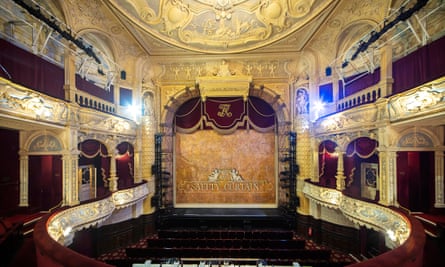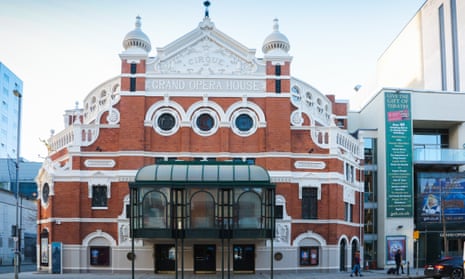A pub quiz question. What do the following have in common: Blackpool Tower Ballroom, the Grand Opera House Belfast, Hackney Empire and the London Palladium? All were the creation of Frank Matcham, the centenary of whose death falls this Sunday. Alan Bennett, a devout admirer, called him “undoubtedly this country’s greatest theatrical architect”. At a time when we are resigned to many more months of virtual playgoing, it is a joy to celebrate the sensuous memories of sitting in one of Matcham’s matchless theatres.
The bare facts of his career are fascinating. He was born in Devon in 1854, was apprenticed at 14 to a Torquay architect, came to London in 1875 and joined the practice of Jethro T Robinson, who was consulting architect to the Lord Chamberlain and whose daughter he went on to marry. After Robinson’s death in 1878, Matcham took over the building of the Elephant and Castle theatre in London. But that was just the start. His explosive heyday lasted from 1891 to 1913, when he designed not just theatres and music halls but such local landmarks as the County Arcade in Leeds, Harrogate’s Royal Hall and the Blackpool Tower Circus. It is estimated that he built or rebuilt more than 150 theatres, of which 26 still thankfully survive.

What makes a Matcham theatre so special? Several things. One is that no two Matcham buildings are alike. The King’s Theatre in Glasgow, with its arcade of conches, is Scots baroque. The Grand Opera House Belfast, all onion domes and elephant heads, is extravagantly oriental. And the London Coliseum – widely considered to be his masterpiece – suggests, through its terracotta facade and Venetian windows, a hymn to the Italian Renaissance. But the Coliseum offers another clue to Matcham’s genius: his ability to combine intimacy and opulence. One of his core beliefs was that every seat should provide a good view; having sat in the rear stalls and circle at the Colly, I can vouch for that.

The penny dropped about his gifts when I read an essay in an excellent volume called Frank Matcham and Co, edited by David Wilmore. Andrew Saint, in a piece entitled Frank Matcham in Perspective, makes the point that Matcham, working in a hectically commercial environment, had little time for rule-based classicism or the refinement of William Morris’s arts and crafts movement. Instead, Saint draws a parallel between Matcham and Dickens, which strikes me as brilliantly perceptive.
John Earl, writing in The Matcham Directory, talks of “the sheer variety of the man’s joyful inventions”. You could apply the same words to Dickens – and, as with the writer, Matcham’s work was often patronised by academic purists. Edwin Sachs, in a triple volume devoted to modern opera houses and theatres, wrote that to illustrate Matcham’s work in such a tome “would be as anomalous as to include the jerry builder’s cottages in a volume on domestic architecture”. That sneer reminds me of FR Leavis excluding Dickens from The Great Tradition on the grounds that, with the exception of Hard Times, his novels lack “a sustained seriousness”.

But the whirligig of time brings its revenges. Matcham’s work was viewed with hostility by the architectural establishment during his own life and for 50 years after his death. Since 1970, however, it has been enthusiastically celebrated. It all started when the threatened demolition of the Lyric Hammersmith in London reminded us that it boasted a magnificent Matcham auditorium.
Then came the discovery of 10,000 previously unseen drawings from the Matcham office that belied the idea of him as some rough-and-ready improviser. Above all, there has been a growing reaction over the past half century against the monochrome monotony of many a civic playhouse. At a time when even the illustrious Denys Lasdun, who designed the National Theatre, was said “to have no language for frivolity”, we crave a bit of Matchamesque panache.

Obviously, you can’t simply reproduce his style today: it was a product of Victorian and Edwardian expansiveness. (It’s striking how many of his suburban music halls were “Empires”.) But we yearn for Matcham’s freewheeling inventiveness and – as the theatre guru Iain Mackintosh pointed out – we now have it in the work of Steve Tompkins. He and his partners have worked on a huge variety of theatres including the Liverpool Everyman, the Bristol Old Vic, the restored grand hall at Battersea Arts Centre in London and the Bridge on the capital’s South Bank. They all have flair, wit and a rapport between stage and audience that is the essence of a first-rate theatre.
When Tompkins was named most influential person in British theatre in the Stage’s annual list in 2019, the paper’s editor, Alistair Smith, hailed Tompkins as a modern Matcham. Before 1970, the comparison would have been meaningless. Today it is the highest compliment a theatre architect can receive. When we eventually get the chance to sit once again in a Matcham theatre, we should take a moment to look around and rejoice in the work of this native theatrical genius.

Comments (…)
Sign in or create your Guardian account to join the discussion